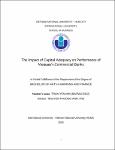| dc.description.abstract | This empirical study is conducted to define and quantify the effects of capital adequacy on the performance of Vietnam’s commercial banks. The study employs the FGLS technique on panel data for 21 commercial banks in Vietnam for the period from 2007 to 2017. Key findings from this study indicate that Bank size (SIZE), Net Interest Margin (NIM), non-interest income (NII), Capital adequacy (REA) are positively related to banks’ performance. In addition, Loan loss provisions (LLP) negatively affect banks’ performance. This study fails to provide empirical evidence to support a relationship between Credit risk (CR) and banks’ performance. The result implies that capital adequacy strongly effects on the performance of commercial banks and that sufficiency of capital can be made to improved performance. Based on the findings, the research recommends improvement in the asset, equity, and deposit from customers in banking that is the best way to enhance the bank's performance.
Keywords: Capital adequacy; banks’ performance; FGLS; Commercial banks, Vietnam. | en_US |


